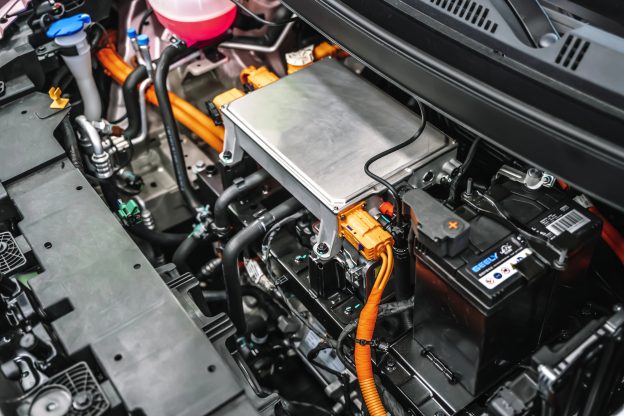China’s export restrictions on heavy rare earths and permanent magnets have garnered the majority of the public’s attention, but a new set of restrictions on battery supply chain technology signal a turning point. The April restrictions on rare earths were a continuation of China’s past approach, focusing on dual-use applications and minerals with small markets. But Beijing’s decision in July to implement export licensing requirements on lithium-ion cathode active materials and lithium extraction technologies marks the start of a new era. The age of economic warfare has now come for the energy transition.
In a move initially proposed in early January, China’s Ministry of Commerce, in coordination with the Ministry of Science and Technology, formally added a series of advanced critical minerals and battery supply chain technologies to the “Catalogue of Technologies Prohibited and Restricted from Export from China.” The most impactful are export-licensing requirements on technologies necessary to produce next generation lithium-iron phosphate (LFP) and lithium manganese iron phosphate (LMFP) cathode active materials along with technologies for direct lithium extraction. Cathode active materials are a core component of a lithium-ion battery that determines its energy density, performance, and cost.
China dominates the global lithium-ion battery supply chain, with particularly overwhelming control over LFP technologies. Chinese companies produce nearly 99 percent of the world’s LFP cathode materials and lead in LFP cell manufacturing, driven by strong domestic demand for affordable electric vehicles. LFP, instead of nickel-manganese-cobalt (NMC), is now the chemistry of choice in the world’s largest EV market. In the context of these restrictions, Chinese companies are also the only companies that have started to produce next-generation LFP cathode active material. Next-generation LFP material significantly increases the energy density of LFP batteries. The higher density allows vehicles to compete with NMC batteries, which have higher energy density, on driving range, without the added cost of additional raw materials like nickel and cobalt. The result is a “best of both worlds” solution: lower-cost EVs with superior performance.
China’s export restrictions on next-generation battery technologies allow Beijing to dictate the global market as these innovations are commercialized. By limiting access to the best LFP technology, Beijing can slow the development of foreign competitors while forcing them to rely on Chinese imports – effectively reinforcing its dominance in the battery supply chain. These controls not only protect and promote domestic manufacturing, but also advance China’s broader strategy of exporting battery technologies and EVs worldwide, as Chinese brands expand their global footprint.
China has also restricted technologies key to direct lithium extraction (DLE). Unlike traditional brine-based methods – which rely on large evaporation ponds and take 18-24 months to yield lithium – DLE technologies can extract lithium in a matter of hours or days. This makes it possible to produce lithium from brine sources that were previously uneconomical or geologically unsuitable. By enabling faster production timelines, reducing water usage, and expanding the geographic footprint of viable lithium projects, DLE could diversify global supply if it is fully commercialized.
The new restrictions target adsorption‑membrane related technologies that are necessary for the development of DLE. Chinese producers, like Sunresin, are the leading providers. As Reuters reported in February, several U.S. companies looking to expand into DLE currently rely on Sunresin’s technologies. U.S. companies could eventually produce their own material, but it would severely slow their extraction development and allow Chinese companies to become the global leaders in a still emerging industry. The United States can support companies like Lilac Solutions and Albemarle that are building non-Chinese technologies to respond to these restrictions.
Previously, China’s export restrictions focused predominantly on materials and technologies with dual-use applications: gallium, germanium, graphite, and most recently heavy rare earths elements and advanced permanent magnets. Graphite and rare earths are necessary for batteries, wind turbines, and electric vehicles but the restrictions were implemented because of their dual use applications. The new restrictions are focused solely on technologies vital to the energy transition. China created key chokepoints in clean energy supply chains, and now Beijing is taking advantage of them. China is exerting its control to slow the development of competitors, support domestic producers, and dictate the next generation of the clean energy economy.
It was inevitable that the “age of economic warfare,” as coined by Edward Fishman in “Chokepoints: American Power in the Age of Economic Warfare,” would eventually find its way into the energy transition. It has already proliferated through all aspects of our economy. The age of economic warfare is marked by the use of tools like sanctions, financial restrictions, export controls, and the weaponization of key chokepoints to exert economic power. As Fishman describes in “Chokepoints,” the modern age of economic warfare has reshaped the global financial system, oil market, and semiconductor industry. It was only a matter of time before the energy transition became entangled.
The shift from export restrictions on raw or processed materials to advanced technologies mirrors Beijing’s broader strategy in the battery supply chain over the last two decades. China began its ascent in the supply chain in the upstream with overseas investments in lithium, cobalt, nickel, and other critical mineral mining projects. Then it moved downstream, leveraging those resources to focus on advanced technologies and build a comprehensive battery supply chain and electric vehicle sector. As global competition over clean energy supply chains intensifies, China is demonstrating that the battle is not just about resources – it’s about who controls the tools of the transition. And Beijing decided to follow the Washington playbook to make their mark.
In September 2022, weeks prior to announcing the United States’ strongest export restrictions to date on advanced semiconductors, Jake Sullivan, the national security adviser for previous U.S President Joe Biden, stated “on export controls, we have to revisit the longstanding premise of maintaining ‘relative’ advantages over competitors in certain key technologies…we must maintain as large of a lead as possible.” The new export restrictions on LFP and DLE allow China to maintain “as large of a lead as possible” in the battery supply chain. Whereas the United States has used export controls to slow down China’s military-adjacent technology sectors, Beijing has adopted a similar playbook, but repurposed it to serve industrial, not security, priorities. China is looking to slow down foreign commercial competitors and support domestic manufacturing rather than denying adversaries military capabilities.
China is following the United States’ playbook, but it remains to be seen if the Trump administration will follow China’s playbook when it comes to responding to technology restrictions. Beijing poured funding into a domestic semiconductor supply chain when the U.S. implemented restrictions on advanced semiconductors. They decided they were going to have to build their own industry if they could not rely on access to leading Western technology.
The Trump administration did follow a similar playbook in response to restrictions on rare earth elements and permanent magnets through the Department of Defense’s investment into MP Materials. The creative funding mechanism aims to build a domestic mine to magnet supply chain. Like Beijing before it, Washington finally realized that it could not allow a competitor to control key chokepoints on technologies necessary for the defense sector. Additionally, rare earths could continue to be a major bargaining chip in any trade negotiations.
But it is highly unlikely the U.S. will follow the same playbook when it comes to LFP technologies. There has been a series of recent announcements of new domestic LFP production from LG, SK ON, and Samsung. However, these efforts are constrained by the absence of domestic cathode production, limited technical expertise in advanced LFP materials, and higher production costs. To compete with China, the United States would have had to double down on the energy transition to build domestic demand and strengthen the Inflation Reduction Act benefits.
Instead, the administration’s antipathy toward policies that support clean energy technologies is effectively ceding the battery supply chain to China, and with it, potentially the future of the auto industry too. The elimination of EV tax credits, weakening of fuel efficiency standards, and the scaling back of manufacturing support will make it extremely difficult for U.S. companies to compete with Chinese companies in next generation battery technology.
Author
-

Kevin Brunelli is a non-resident fellow at the Center on Global Energy Policy at Columbia University. He was previously on the Critical Minerals and Energy Technologies team at the U.S. State Department where he served as the lead for East Asia and Australia along with lithium, nickel, and minerals and technologies facing export restrictions from China.



